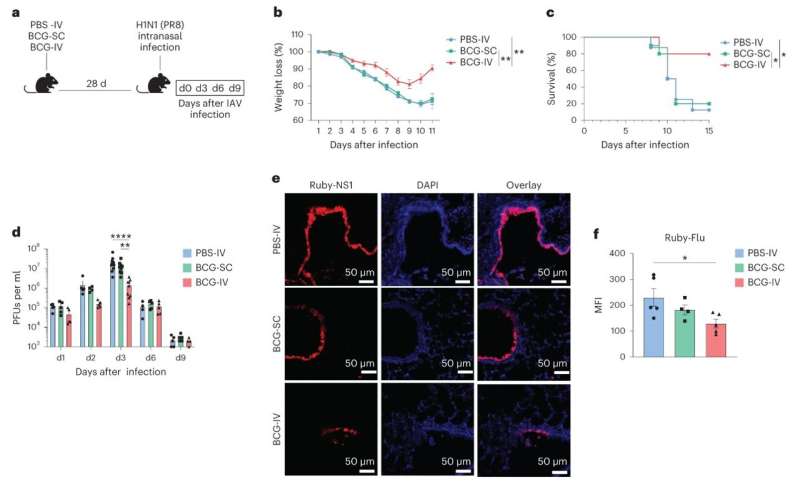a, The mouse model of BCG vaccination and IAV infection. b,c, Morbidity and mortality of mice infected with the lethal dose of PR8 (120 PFUs; n = 9–10). d, Viral load at various timepoints after infection with a sublethal dose of IAV-PR8 (50 PFUs; n = 4–8). e, Confocal microscopy of lung section infected with Ruby-NS1 IAV strain 3 d after infection (sublethal dose; 500 PFUs). f, Quantification of mean fluorescence intensity of Ruby-NS1 expression on lung sections (n = 4). Credit: Nature Immunology (2024). DOI: 10.1038/s41590-023-01739-z
As Canada's flu season collides with record strep A cases and ongoing COVID-19 concerns, a new study is shedding light on our understanding of respiratory immune responses. Scholars from the Research Institute of the McGill University Health Center (RI-MUHC) have discovered a surprising facet about a century-old vaccine for tuberculosis, Bacillus Calmette Guérin (BCG).
The study, published in the journal Nature Immunology, uncovered a previously unknown mechanism that extends the vaccine's shield to combat influenza A virus—the most prevalent flu strain.
"The immune interactions involved here can 'train' the lungs, which are frequently exposed to infectious agents in the environment. If we can map out the protective immune pathways involved in the lungs, this will revolutionize our conceptual and clinical approaches in developing vaccines against infections, including emergent respiratory viruses," explains lead author Maziar Divangahi, a pulmonary immunologist, a senior scientist at the RI-MUHC, and a Professor of Medicine at McGill University.
The discovery paves the way for future studies to assess whether BCG could be used to prevent other emergent viruses. Notably, research on the vaccine's protection against COVID-19 has had promising results.
More information: Kim A. Tran et al, BCG immunization induces CX3CR1hi effector memory T cells to provide cross-protection via IFN-γ-mediated trained immunity, Nature Immunology (2024). DOI: 10.1038/s41590-023-01739-z
Journal information: Nature Immunology
Provided by McGill University
























